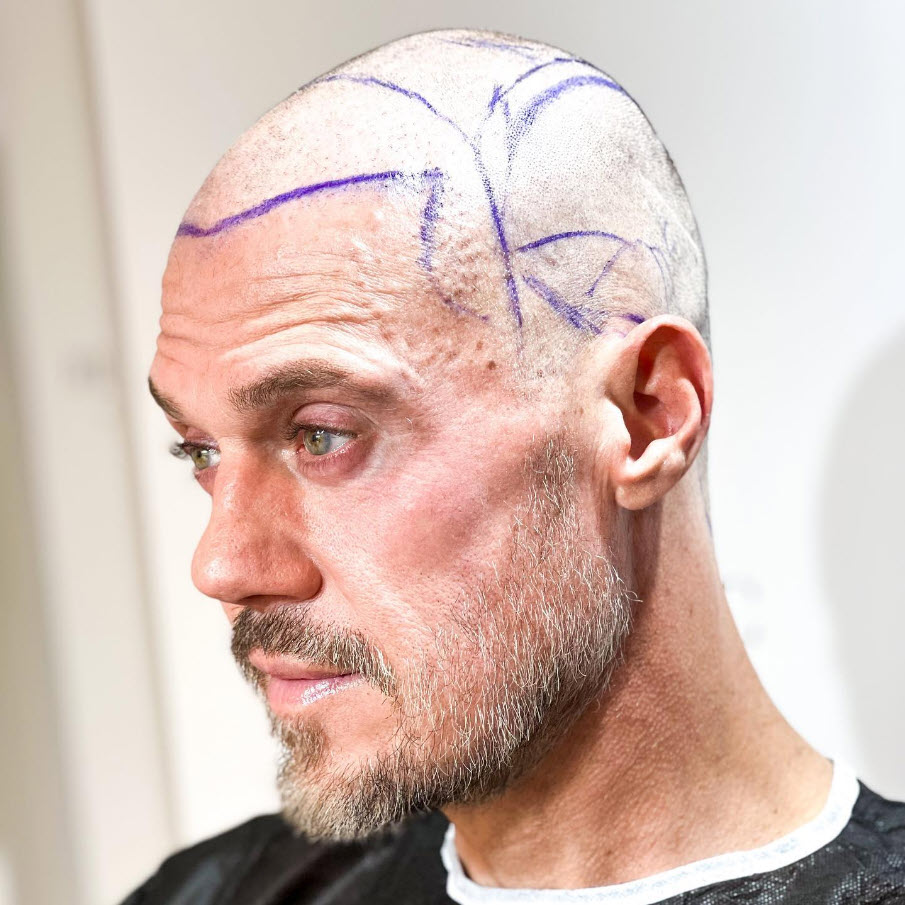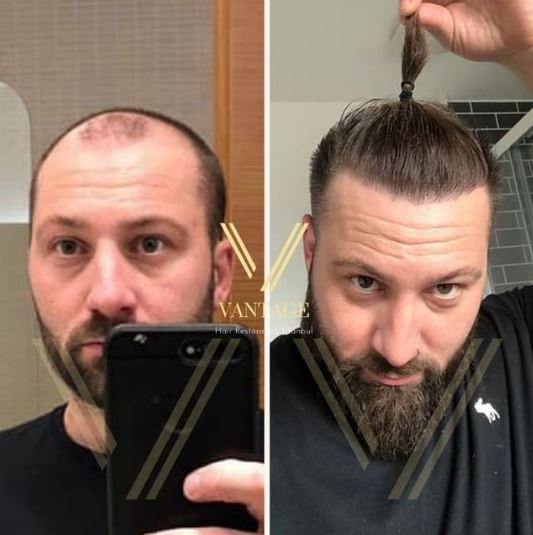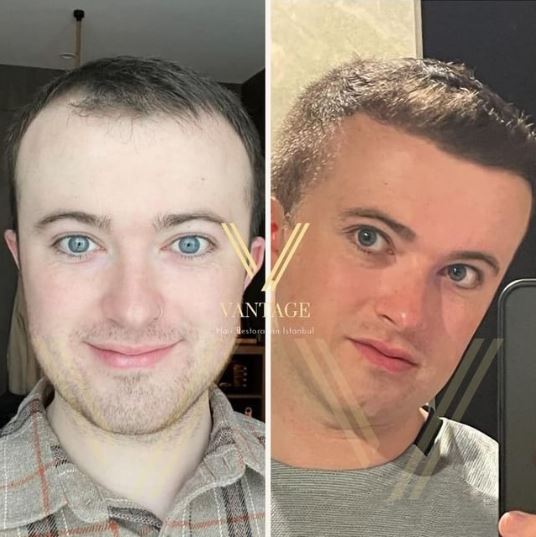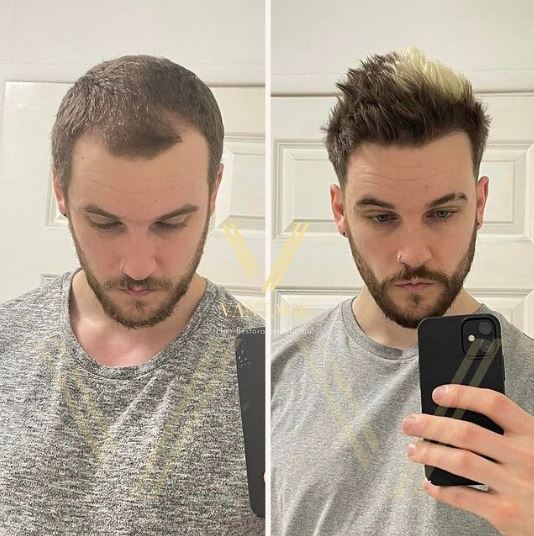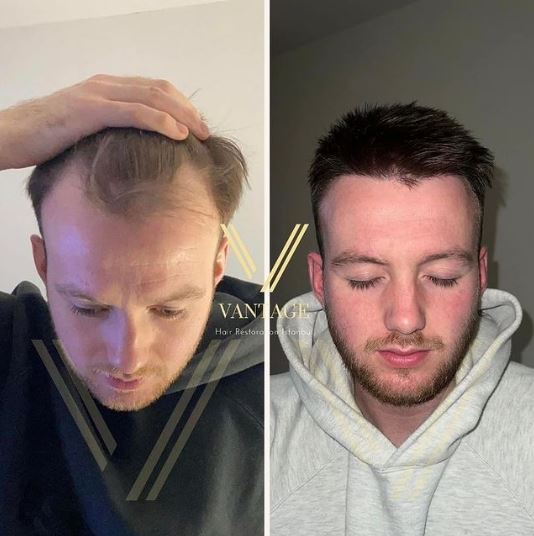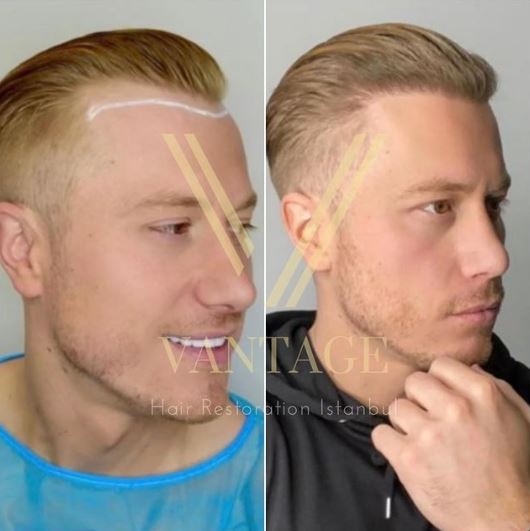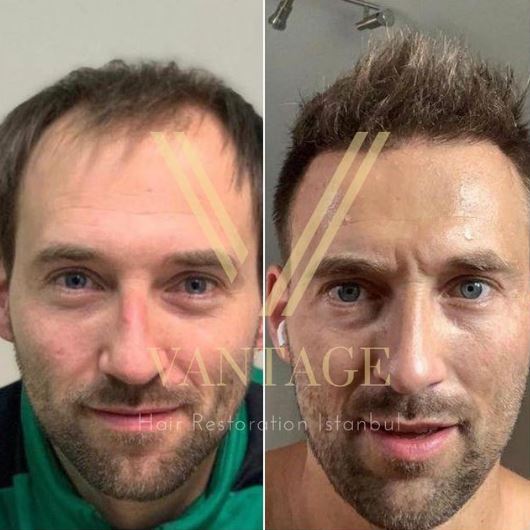Hair transplant aftercare is an important process that can affect your hair transplant results greatly. A good hair transplant is only possible with a combination of an experienced team, realistic expectation, right technique and attentive aftercare.
That’s why it’s understandable that patients have a lot of questions regarding the post-hair transplant process. We have answered your post-hair transplant FAQs.
You can see all the frequently asked questions below. If your question is not there, please feel free to reach us and our medical team will give you a detailed answer.

How do you cover your head after hair transplant?
There are different ways to cover your head after getting a hair transplant. One option is to wear a cap, but it’s essential to be careful about the type of hat you choose. It’s best to wear a loose-fitting hat made of breathable fabric, such as a fishing or bucket hat, rather than a tight-fitting one. Another option is to wear a scarf, which can be a stylish way to cover your head after the procedure. Alternatively, consider getting a bold haircut before the transplant to make any changes less noticeable.
Can I wear a hat after a hair transplant?
Many people want to wear a hat after their hair transplant procedure whether this is to protect their head from the sun or to cover up the transplant area before they are ready to show their new hair to others. Normally, you need to wait for the newly transplanted hair follicles to settle in before you can wear a cap or a hat. This process usually takes 10-14 days after a hair transplant procedure. However, our clinic provides a special hat that can be worn after a hair transplant.

When can I touch my hair after a transplant?
It is important to give the transplanted hair follicles time to settle in before touching the area. In the first few days, you will see scabs will form around the transplanted hair follicles. Do not scratch, touch or peel these scabs to avoid any scarring.
You should not touch the transplanted area at all during the first 3-5 days. After this period, you can gently touch the area to apply itching ointment to the scabs. It is usually safe to touch the area after 2 weeks, however, it is always a good idea to be as gentle as possible.
When can I rub my head after hair transplant?
Although massaging your scalp can improve blood circulation and promote hair growth, it is important to wait until the hair grafts are firmly established before you massage your head after a hair transplant. This process usually takes around 10-12 days. Once the grafts are secure, you can safely massage head after hair transplant to promote healthy blood flow and hair growth.

Can I go outside after hair transplant?
After undergoing a hair transplant, you don’t have to worry about going outside. Wear a hat or umbrella if necessary, and avoid touching or scratching your scalp. By taking these precautions, you can safely go outside after the procedure.
Can I Go To Work After Hair Transplant?
Based on your job requirements, the duration of taking a break after a hair transplant may vary. If your job involves heavy physical labor, it may take around 7-10 days to return to work. On the other hand, if you work at a desk in a comfortable environment, you can return to work earlier.

Can I go to the gym after hair transplant?
After undergoing a hair transplant, allowing the grafts to settle into the recipient area is essential. It is advisable to avoid going to the gym for approximately three weeks after the procedure to prevent excessive tension, sweating, and other strenuous activities from damaging the newly transplanted hair follicles. Once this period has passed, you can safely resume your usual workout routine. Remember to take it easy and follow your doctor’s instructions closely to ensure a successful recovery.
Workout After Hair Transplant
Two weeks after hair transplant, you can start with lighter workouts to ease in and avoid over-sweating.
Running After Hair Transplant
Because running is one of the most strenuous activities, it might be a good idea to start slow after the 2 weeks after hair transplant.
Swimming After Hair Transplant
Swimming is different to any other activity since it would involve either using a swimming cap or getting your hair wet. It is advised to avoid keeping the transplanted area wet until the healing process is complete. Furthermore, seawater and pool water may contain irritants and pollutants that you want to avoid during the healing period.
Usually, it can take 1-2 months before patients are able to go back to swimming after hair transplant.
Sauna After Hair Transplant
Following the procedure, it is crucial to maintain an optimum moisture level in your scalp to promote the proper growth of hair follicles. As such, it is advisable to refrain from sunbathing, visiting saunas, or exposing your scalp to heavily moisturized environments for at least two weeks after hair transplant.
Lift Weights After Hair Transplant
Intense exercise, such as weightlifting, can result in excessive sweating, which in turn creates a welcoming environment for inflammation to occur after hair transplant.
Sweat After Hair Transplant
Sweating does not cause hair grafts to fall out or affect the settling of new hair follicles. However, it can create a favorable environment for infection and irritation. Therefore, it is recommended to avoid activities that involve heavy sweating, such as intense workouts, steam rooms, or similar activities, for at least a month after the hair transplant surgery.

When can I sleep normally after hair transplant?
After a hair transplant, it is crucial to keep the hair grafts secure to ensure a higher success rate and better results. Therefore, it is important to keep your head elevated after the procedure to ensure the safety of both the recipient and donor areas. Once the hair grafts are secured, and the donor area has recovered, you can return to your regular sleeping position, which may take up to two weeks after the procedure.
When can I sleep on my side after a hair transplant?
During the first few nights post-surgery, you sleep with your head elevated on a few pillows to minimize swelling. After the initial recovery period, which typically lasts around a week, you may gradually resume your regular sleeping habits, including sleeping on your side.

Can I drink coffee after a hair transplant?
Since caffeine increases your blood pressure, it is advisable to avoid drinking coffee 24 hours before and after the operation. Also, it’s recommended not to consume other caffeinated drinks such as coke, energy drinks, black and green tea.

Can I drink alcohol after a hair transplant?
It is recommended to avoid drinking alcohol for the first 10 days after your surgery to ensure that it does not interfere with the healing and adaptation of the transplanted hair follicles.

Can I drink coke after hair transplant?
It is crucial to avoid beverages that are high in sugar and acid, like Coke, soda, etc., as they may inhibit the recovery process by rapidly increasing blood sugar. Additionally, consuming acidic beverages, like Coke, shortly after surgery may irritate the stomach and potentially impact the healing process. Thus, it is essential to prioritize a healthy diet that supports the body’s recovery without introducing any unnecessary irritants.

Can I drink milk after hair transplant?
To promote healthy hair growth and improve the overall health of your scalp, it is essential to increase your protein intake. Drinking milk after a hair transplant procedure may help you achieve this goal.

Can I drink tea after hair transplant?
After a hair transplant, it’s generally okay to drink tea, but consider moderation, especially with caffeinated varieties, as excessive caffeine intake might impact blood pressure or hydration levels. Opting for herbal teas without caffeine can be a gentler choice. Avoid very hot beverages to prevent discomfort or irritation to the healing scalp. Stay well-hydrated by including water in your beverage intake. Always follow your surgeon’s specific post-operative guidelines, which may have recommendations or restrictions tailored to your individual recovery needs.

Can I eat spicy food after hair transplant?
Consuming heavily seasoned and spiced food after hair transplant is not advisable as it may increase swelling. Additionally, studies suggest that spicy food may increase blood flow, leading to excessive bleeding after the procedure.

Can I smoke after a hair transplant?
Smoking has negative impacts on blood circulation and clotting. It is advisable to quit smoking for 10 days after your hair transplant.

Can I use toppik after a hair transplant?
Toppik or hair fibres can be great to camouflage the transplanted areas however you should wait for the scabs to fall out and recipient area to get healed before you apply toppik. This process usually takes minimum of 1 month after the operation.
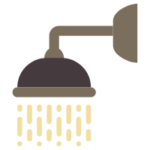
When can I shower after a hair transplant?
For the first 24 hours after hair transplant, it is vital to keep your scalp dry. After the first day, our medical team will conduct the first wash at our clinic. Once the first wash is done, you can wash your hair once or twice a day, depending on your hair’s needs. Therefore, you can shower using lukewarm water with low pressure after the first day.
When can I wash my hair normally after hair transplant?
After the first wash, it is recommended that you wash your hair only once or twice a day for a period of 15 days. After the 15-day period, you can then return to your normal hair care routine.
When can I use normal shampoo after a hair transplant?
To achieve the best results after a hair transplant, it is crucial to follow a reliable aftercare routine. During the first month following the transplant, it is recommended that you avoid shampoos and hair care products that contain paraben, silicon, perfume, SLS, and other harsh chemicals. After completing the first month, you can resume using your regular hair care products.
How often do you wash hair after hair transplant?
After undergoing a hair transplant procedure, washing your hair once or twice a day for the first 15 days is highly recommended. This ensures that the transplanted hair follicles are kept clean and free from any infections that may lead to complications. After the first 15 days, you can return to your usual frequency of washing your hair.

When can I use normal shampoo after a hair transplant?
You can go back to your normal shampoo after 2 weeks of your hair transplant operation. However, please consult with your surgeon before moving on to your normal shampoo.
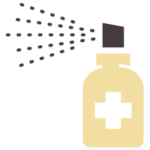
Do you have to take medication after hair transplant?
To minimize post-procedure discomfort and pain, our surgeon will prescribe painkillers, antibiotics, and vitamins that should be taken as directed.
Do you have to take a finasteride after hair transplant?
Finasteride is a medication that the FDA has approved to reduce the size of the prostate. It works by inhibiting the 5-alpha reductase enzyme, which prevents the conversion of testosterone to dihydrotestosterone, a hormone that contributes to male pattern baldness. While Finasteride can effectively stop hair loss in the short term, it should not be taken lightly. Its hormonal effects may cause serious side effects, such as abnormal growth in the mammary glands, particularly in men.
After a hair transplant, there’s no need to use Finasteride. However, if you still want to use it, it should be monitored by an expert.
When to stop finasteride after hair transplant?
If you plan to use Finasteride after a hair transplant, it’s recommended that you start using it a month after the procedure. It’s essential to have an expert monitor your medication use; if you decide to stop taking it, you should consult with your expert first. Remember that suddenly stopping the use of Finasteride may cause you to experience sudden hair loss of your existing hair, so the timing of when you stop taking it will depend on your individual needs. Additionally, it’s essential to follow the correct dosage and any other instructions your doctor provides to ensure the medication is used safely and effectively.
When can I use minoxidil after a hair transplant?
Minoxidil, an FDA-approved medication, is typically used topically to stop hair loss. The medication acts as a vasodilator, which enhances blood flow in vessels at the applied region. You may begin using Minoxidil two weeks after the procedure, but it is crucial to use it under the supervision of an expert.
When to stop minoxidil after hair transplant?
As mentioned, it is safe to start using Minoxidil two weeks after the procedure. However, if you experience any itching or irritation, it is advisable to discontinue using Minoxidil and wait until the irritation subsides before using it again. If you notice any irritation, please consult your surgeon or general practitioner and follow their advice on how to proceed. Prioritizing your health and safety is essential, so do not hesitate to seek medical advice if you have any concerns.

Can I drive after a hair transplant?
Driving after a hair transplant is not recommended, but the answer depends on what type of anaesthetic procedure you had. Hair transplant is geerally conducted under local anaesthesia. If you were put on strong sedatives, it is not advised to be driving for the next 24 hours after the surgery.

Can I have sex after a hair transplant?
Sex can lead to excessive sweating and increased blood pressure. This is why you should avoid having sex for at least 1 week after a hair transplant.
Can I masturbate after hair transplant?
Patients should refrain from masturbating for about ten days after hair transplant. During this time, it is vital to be cautious and not come into contact with the transplanted scalp area in order to keep the fragile follicles in place. In addition, it’s best to do these exercises slowly, especially in a cool environment, to reduce the chance of perspiration.

Can I wear a wig after a hair transplant?
Because wigs create pressure on the scalp, they can negatively affect the transplanted hair follicles especially during the rcovery process. To avoid damaging your newly transplanted hair, wait for at least 2 weeks before wearing a wig.

Can I dye my hair after a hair transplant?
Hair dyes contain a lot of strong chemicals that can irritate the transplanted or donor area. Just to be safe, you should wait for 4-6 weeks before dying your hair after a hair transplant.

When Can I Get A Haircut After Hair Transplant?
After your hair transplant surgery, you may be excited to style your new hair. However, giving your hair enough time to recover and adjust to its new growth is vital. It is generally recommended to wait at least a month before getting a haircut after a hair transplant.
When can I use clippers after hair transplant?
It is essential to properly care for the entire head after a hair transplant, not just the recipient area. Once the scabbing phase is over, you can use clippers on the rest of your hair. However, it is advisable to wait for a little while before using clippers on the transplanted area to allow your newly transplanted hair to settle in securely. This process may take 2-3 months to use clippers on your transplanted hair.

How to remove scabs after hair transplant?
After a hair transplant, it is expected to experience scabbing as the blood flow increases in the scalp. To remove the scabs after hair transplant, you should apply panthenol foam to your scalp and let it sit for 30 minutes to soften the scabs. After that, rinse it with lukewarm water. You should also wash your hair with medical shampoo by applying it gently. Then, dry it gently with gauze. Following these steps after scabbing occurs can help you get rid of them quickly.

Is it necessary to spray saline water after hair transplant?
Spraying the saline solution on the recipient area using a spray bottle every 2-3 hours is recommended to enhance moisture in the recipient area. If the spray bottle is unavailable, a standard saline solution can be used through injection. Some experts suggest using the saline solution 5-7 days after the hair transplant procedure or until it is no longer required.

How to prevent shock loss after hair transplant?
After a hair transplant, avoiding hot water and rubbing the scalp is recommended, as well as limiting strenuous activities, sun exposure, and tight hairstyles to prevent shock loss. Smoking and excessive drinking should be avoided. To ensure proper healing, use a travel pillow to sleep with an elevated head and attend all follow-up appointments. Maintaining overall well-being with a balanced diet, hydration, and stress management is crucial.
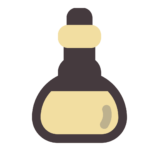
Can I apply oil after hair transplant?
After a hair transplant, you may use essential oil in the donor area, but only after two weeks from the hair transplant. Applying oil to the recipient area may provide some relief if you experience any itching or dryness in the healing area. However, the scalp needs sufficient time to heal before applying oil. Furthermore, it’s important to note that you should only do this after 10 to 12 weeks from your procedure.

